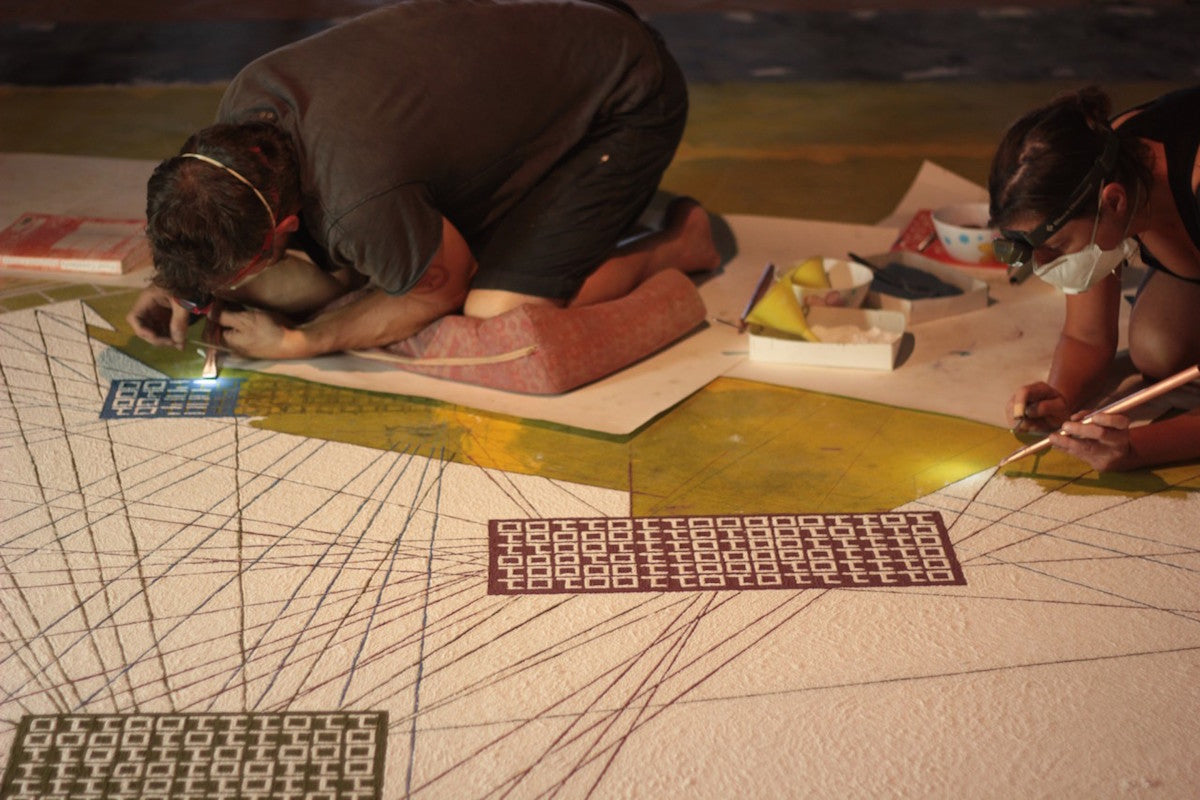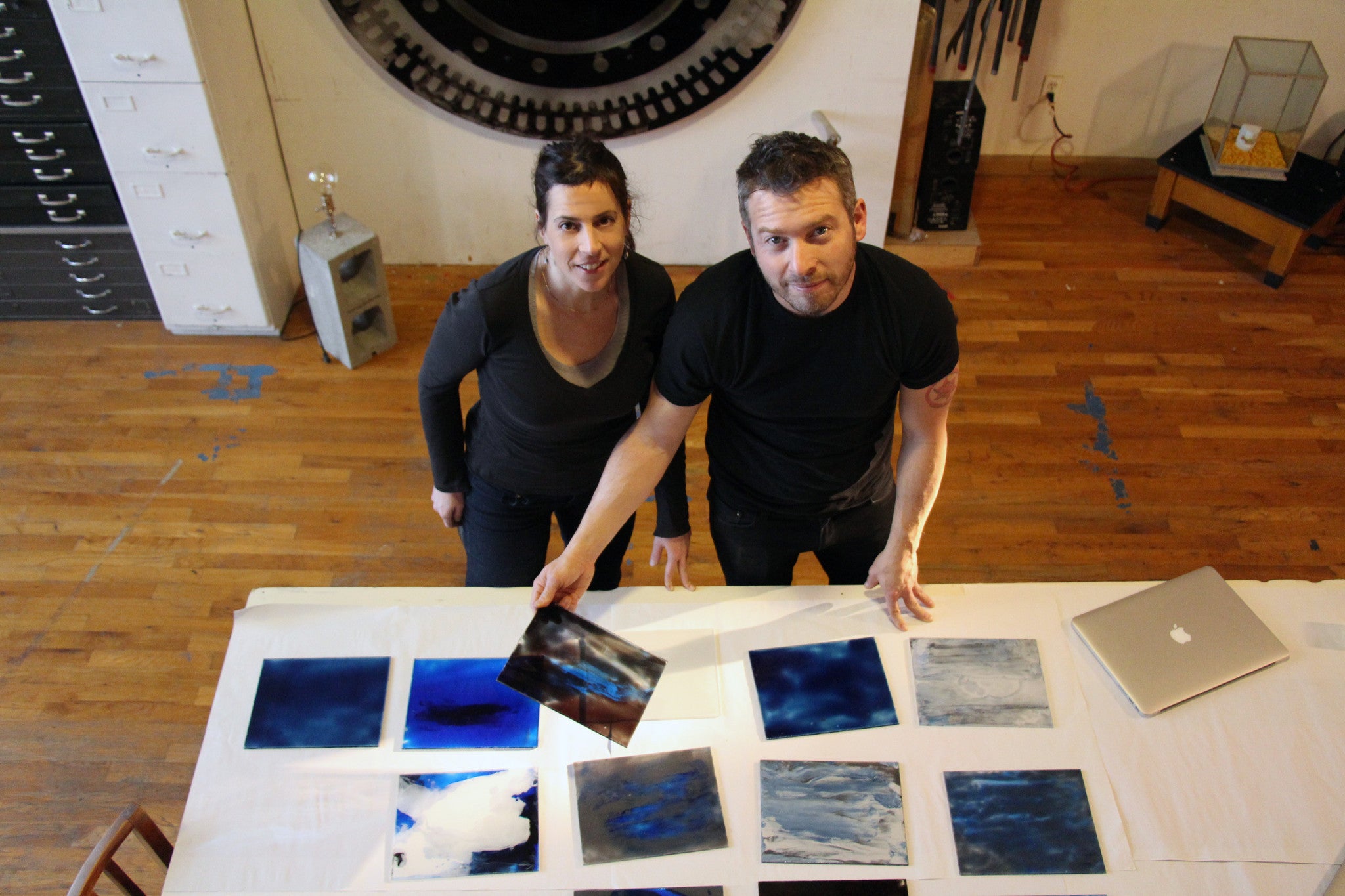Erin: What are you curious about?
Chris & Patrick: New processes, new materials, data, information, travel and meditation.
Erin: Describe your art and describe your process.
Chris & Patrick: Our work is multidisciplinary and our subject matter tends to be driven by specific projects. Overall, we look to explore everything from ancient practices to digital processes and beyond. From printmaking to video mapping, materials from steel to composites, we look to explore every expressive opportunity that we can find. Our last project was a month long performance combining ancient sand painting techniques with gps data mapping. We are not only looking for ways to use current technologies but also looking for ways to translate this to a human scale. Our process starts with a shared idea. We build upon that by opening it up to as many possible variations until the idea makes sense, not only in concept but aesthetically as well.
Erin: You both have had independent successful careers as artists. How did you start working together as a team?
Chris & Patrick: We’ve worked side by side for the past 20 years. In 2010, we embarked on our first direct collaboration with Symphony in D Minor. Until this point we had never truly collaborated, we have shown together more often than not and our work has always complimented each others, but as we began to work together on this project everything began to click and our unique talents joined together to be a good fit. When we first decided we wanted to collaborate, we came up with the idea of making interactive musical instruments, but we wanted to create something epic. We wanted it to go beyond simple touch and play/cause and effect, we wanted it to have depth and power. Then one day while we were heading home we got stuck in a storm. We tucked into a place to get out of the rain, ordered a bottle of wine and stared out the window listening to the amazing symphony that was unfolding in front of us. That was our eureka moment. We haven’t looked back since.
Erin: Working together now, how have you influenced each other's approach?
Chris & Patrick: While we are extremely compatible and we have the same work ethics, our approach is very different. We’ve had to navigate that and learn each others methods as if we’d just met. It’s given us each a new perspective on how to approach large scale projects. The only way to collaborate, is communication and trust.
Erin: Symphony in D Minor is an astounding lifetime artistic achievement. Tell us about how you made this idea a reality and about it's new home in Poland.
Chris & Patrick: Magic!!! There is truly no other word for it. The moment the idea and concept came together, doors began to open and things began to unfold. For 2 years we worked tirelessly, not knowing how we would make this project happen, but with every hurdle, came an opportunity. We knew, no matter what, that this project had to happen. Nothing else mattered. Symphony in D Minor has gone to Poland as a permanent installation at a newly opening museum called the Hydropolis in Wroclaw, Poland. The museum is located underground in a 19th century German reservoir and is set to open late 2015 to correspond with Wroclaw being the culture capital for the European Union in 2016.
Erin: For 2751 kilometers / 2621 grams you both painfully worked 30 days on your hands and knees in a spanish monastery to create a mandala that was intended to be destroyed. Tell us about this residency and how meditation has now become part of your lives and work.
Chris & Patrick: La Fragua is an amazing artist residency hosted in a 15th century monastery in Belalcázar, Spain. We were invited there for the month of July in 2014 where we created an infographic mandala about the trek through Spain we had just completed. The goal of the mandala was to share our experience. The method we employed highlighted every facet of the journey. The process of creating the piece was a very powerful expression of that experience. Each line and every dot was carefully placed. It was exhausting, painful, beautiful and amazing, much like the trek itself. The sweeping away was poetic, it reflected on the impermanence of everything: life, memories and experience. We started vedic meditation almost 2 years ago. It has been life changing. About a month into meditation, we decided to finally commit to an 1100 km trek that we have been wanting to do for over 10 years. As soon as we booked our tickets, everything started to fall into place for us. We were invited to the residency just a few weeks later and the museum in Poland contacted us right there after. These were not necessarily a result of meditation but the decisions that led to them were a result of a clearer perspective.

Erin: What's the most life-changing experience you've had during your travels and artistic explorations?
Chris & Patrick: Realizing how much more we want to see and explore. Realizing how much power we have over our own existence.
Erin: Data is an important theme to you both. How do you see society and art changing because of the information and technology that is now at our fingertips?
Chris & Patrick: Data is information and we live in an information age. In one perspective it can be abstract but another it can be insightful and relevant. It is powerful in context and quite beautiful on it's own. Art is always a reflection of it's time. Our time is filled with unprecedented amounts of data. We collect it, analyze it, review it and manipulate it. How we visualize this plays a key role as to how we see the world around us. This is true for society as well as art.
Erin: Chris, you've studied photography but have worked in sculpture (often with resin and light). Patrick, you studied glass work and painting then moved onto photography.
Chris: I’ve been a sculptor my whole life, starting off at the early age of 5. It has truly always been my passion. The last two years of high school I fell in love with photography. I got a full scholarship to a summer art program and continued with it into university. Although my end product was a photograph, I focused on installations that I created, using lighting and people to create scenes that portrayed a story. Once I left school, I realized the thing I had been missing was the tactile element. I quickly came back to my sculpture roots and I’ve rarely picked up a camera since. However, the skills I’ve learned from photography have carried over into everything I do. I’m very conscious of perspective and how things are viewed through a lens. One of the things that really helps us as collaborators, is that we both have a vast knowledge of many different mediums. And we can apply our skills in many ways and understand the possibility of combining different techniques.
Patrick: I began as an artist drawing and painting. In college, I immediately gravitated toward glass blowing and casting. There was a lot of interesting and innovative work happening in glass at that time. It was exciting and seductive. I was drawn by the powerful process of working in front of 2500+ ºF furnaces and handling raw molten materials. After moving to NYC, I did not follow the path of glass but I did keep my eye on a lot of the qualities I appreciated in the material. Mainly translucency and light reactiveness. I dove heavily into painting, first working traditionally on canvas and paper, then developing the use of new materials such as light reactive paint, plastics surfaces, internal L.E.D. lighting and projections. From there, I began to discover video, which in turn dovetailed perfectly with photography. All of this led me to realize that while the process may change, the approach is the same. Careful, focused and disciplined.
Erin: How do you jointly choose what materials you'll be working with when approaching a new body of work?
Chris & Patrick: Mostly we let the artwork choose the material. We’re very conscious that the materials used have to correlate to what we are trying to convey. There has to be meaning to every aspect of the artwork. The qualities of materials we choose must enhance what we are trying to express. We belong to Materials Library, which a great source for exploring what might work for our next project.
Erin: Now that you've actually done your dream project, what are you dreaming up next?
Chris & Patrick: We just started a new series called dataatadata which concentrates on the beauty and power of raw information. We have a few large scale interactive installations in the works that will be centered around information.
Erin: If you had one superpower, what would it be?
Chris: To learn anything to perfection in 5 mins. Think the Matrix… “I know Kung Fu.”
Patrick: I wouldn’t mind time travel but at this point I’d be happy with just being able to remember people's names.
Erin: You've been artists working in brooklyn for 15/20 years. How has your experience of the art scene changed.
Chris & Patrick: The art scene has changed tremendously, especially here in Brooklyn. The creative energy that has propelled Brooklyn for the past 10 years has had an effect on not only the work being produced but also how it is shown. Every few decades there seems to be a shift in overall aesthetics, right now there is a strong new dynamic developing and people are looking push boundaries. It's an exciting place to be.










